Numerical Simulation of Thermal Processes in a Domain of Thin Metal Film Subjected to an Ultrashort Laser Pulse
Abstract
:1. Introduction
2. Governing Equations
3. One-Domain Approach
4. Two Forms of the Dual Phase Lag Equation
5. Boundary and Initial Conditions
6. Numerical Algorithm
7. Results of Computations
8. Conclusions
Definition of Symbols
| c | volumetric specific heat [W/(m3K)] |
| C | substitute thermal capacity [W/(m3K)] |
| f | level of time |
| fS | volumetric solid-state fraction |
| fL | volumetric liquid state fraction |
| I0 | laser intensity [J/m2] |
| L | volumetric heat of fusion [J/m3] |
| q | heat flux vector [W/m2] |
| Q | capacity of internal heat sources [W/m3] |
| QL | source function resulting from the laser action [W/m3] |
| Qph | source function related to melting [W/m3] |
| R | reflectivity of the irradiated surface |
| R0 | domain radius [m] |
| rD | laser beam radius [m] |
| T | temperature [K] |
| T * | melting temperature [K] |
| [T1, T2] | temperature interval in which the melting process takes place |
| Tp | initial temperature [K] |
| t | time [s] |
| tp | characteristic time of laser pulse [s] |
| X = {r, z} | geometrical co-ordinates |
| Z | domain depth [m] |
| Greeks: | |
| δ | optical penetration depth [m] |
| λ | thermal conductivity [W/(mK)] |
| τT | thermalization time [s] |
| τq | relaxation time [s] |
Author Contributions
Funding
Conflicts of Interest
References
- Tzou, D.Y. Macro- to Microscale Heat Transfer: the Lagging Behavior, 2nd ed.; Wiley: New York, NY, USA, 2014. [Google Scholar]
- Zhang, Z.M. Nano/Microscale Heat Transfer; McGraw-Hill: New York, NY, USA, 2007. [Google Scholar]
- Smith, A.N.; Norris, P.M. Microscale heat transfer. Heat Transfer Handbook; Chap. 18; John Willey & Sons: Hoboken, NJ, USA, 2003; pp. 1309–1357. [Google Scholar]
- Faghri, A.; Zhang, Y.; Howell, Y. Advanced Heat and Mass Transfer; Global Digital Press: Kanpur, India, 2010. [Google Scholar]
- Tamma, K.K.; Zhou, X. Macroscale and microscale thermal transport and thermomechanical interactions: some noteworthy perspectives. J. Therm. Stress. 1998, 21, 405–449. [Google Scholar] [CrossRef]
- Deng, D.; Jiang, Y.; Liang, D. High-order finite difference method for a second-order dual-phase-lagging models of microscale heat transfer. Appl. Math. Comput. 2017, 309, 31–48. [Google Scholar] [CrossRef]
- Askarizadeh, H.; Baniasadi, E.; Ahmadikia, H. Equilibrium and non-eqilibrium thermodynamic analysis of high-order dual-phase-lag heat conduction. Int. J. Heat Mass Transf. 2017, 104, 301–309. [Google Scholar] [CrossRef]
- Majchrzak, E.; Mochnacki, B. Implicit scheme of the finite difference method for a second-order dual phase lag equation. J. Theor. Appl. Mech. 2018, 56, 393–402. [Google Scholar] [CrossRef]
- Chiriţă, S.; Ciarletta, M.; Tibullo, V. On the thermomechanical consistency of the time differential dual phae-lag-models of heat conduction. Int. J. Heat Mass Transf. 2017, 114, 277–285. [Google Scholar] [CrossRef]
- Fabrizio, M.; Lazzari, B. Stability and second law of thermodynamics in dual-phase-lag heat conduction. Int. J. Heat Mass Transf. 2014, 74, 484–489. [Google Scholar] [CrossRef]
- Quintanilla, R.; Racke, R. A note on stability in dual-phase lag heat conduction. Int. J. Heat Mass Transf. 2006, 49, 1209–1213. [Google Scholar] [CrossRef]
- Tang, D.W.; Araki, N. Wavy, wavelike, diffusive thermal responses of finite rigid slabs to high-speed heating of laser-pulses. Int. J. Heat Mass Transf. 1999, 42, 855–860. [Google Scholar] [CrossRef]
- Castro, M.A.; Rodríguez, F.; Escolano, J.; Martín, J.A. Exact and analytic-numerical solutions of lagging models of heat transfer in a semi-infinite medium. Abstr. Appl. Anal. 2013, 2013. [Google Scholar] [CrossRef]
- Ciesielski, M. Analytical solution of the dual phase lag equation describing the laser heating of thin metal film. J. Appl. Math. Comput. Mech. 2017, 16, 33–40. [Google Scholar] [CrossRef] [Green Version]
- Mohammadi-Fakhar, V.; Momeni-Masuleh, S.H. An approximate analytic solution of the heat conduction equation at nanoscale. Phys. Lett. A 2010, 374, 595–604. [Google Scholar] [CrossRef]
- Ramadan, K. Semi-analytical solutions for the dual phase lag heat conduction in multi-layered media. Int. J. Therm. Sci. 2009, 48, 14–25. [Google Scholar] [CrossRef]
- Kumar, S.; Srivastava, A. Finite integral transform-based analytical solutions of dual phase lag bio-heat transfer equation. Appl. Math. Model. 2017, 52, 378–403. [Google Scholar] [CrossRef]
- Liu, K.C.; Wang, J.C. Analysis of thermal damage to laser irradiated tissue based on the dual-phase-lag model. Int. J. Heat Mass Transf. 2014, 70, 621–628. [Google Scholar] [CrossRef]
- Majchrzak, E. Numerical solution of dual phase lag model of bioheat transfer using the general boundary element method. Comput. Model. Eng. Sci. 2010, 69, 43–60. [Google Scholar]
- Kumar, D.; Rai, K.N. A study on thermal damage during hyperthermia treatment based on DPL model for multilayer tissues using finite element Legendre wavelet Galerkin approach. J. Therm. Biol. 2016, 62, 170–180. [Google Scholar] [CrossRef] [PubMed]
- Kumar, D.; Kumar, P.; Rai, K.N. A study on DPL model of heat transfer in bi-layer tissues during MFH treatment. Comput. Biol. Med. 2016, 75, 160–172. [Google Scholar] [CrossRef] [PubMed]
- Kumar, P.; Kumar, D.; Rai, K.N. A numerical study of dual-phase-lag model of bio-heat transfer during hyperthermia treatment. J. Therm. Biol. 2015, 49, 98–105. [Google Scholar] [CrossRef] [PubMed]
- Kumar, S.; Srivastava, A. Thermal analysis of laser-irradiated tissue phantoms using dual phase lag model coupled with transient radiative transfer equation. Int. J. Heat Mass Transf. 2015, 90, 466–479. [Google Scholar] [CrossRef]
- Phadnis, A.; Kumar, S.; Srivastava, A. Numerical investigation of thermal response of laser-irradiated biological tissue phantoms embedded with gold nanoshells. J. Therm. Biol. 2016, 61, 16–28. [Google Scholar] [CrossRef] [PubMed]
- Mochnacki, B.; Ciesielski, M. Micro-scale heat transfer. Algorithm basing on the control volume method and the identification of relaxation and thermalization times using the search method. Comput. Methods Mater. Sci. 2015, 15, 353–361. [Google Scholar]
- Patidar, S.; Kumar, S.; Srivastava, A.; Singh, S. Dual phase lag model-based thermal analysis of tissue phantoms using lattice Boltzmann method. Int. J. Therm. Sci. 2016, 103, 41–56. [Google Scholar] [CrossRef]
- Ho, J.R.; Kuo, C.P.; Jiaung, W.S. Study of heat transfer in multilayered structure within the framework of dual-phase-lag heat conduction model using lattice Boltzmann method. Int. J. Heat Mass Transf. 2013, 46, 55–69. [Google Scholar] [CrossRef]
- Wang, H.; Dai, W.; Melnik, R. A finite difference method for studying thermal deformation in a double-layered thin film exposed to ultrashort pulsed lasers. Int. J. Therm. Sci. 2008, 47, 7–24. [Google Scholar] [CrossRef]
- Majchrzak, E.; Mochnacki, B.; Greer, A.L.; Suchy, J.S. Numerical modeling of short pulse laser interactions with multi-layered thin metal films. Comput. Model. Eng. Sci. 2009, 41, 131–146. [Google Scholar]
- Majchrzak, E.; Kałuża, G. Analysis of thermal processes occurring in the heated multilayered metal films using the dual-phase lag model. Arch. Mech. 2017, 69, 275–287. [Google Scholar]
- Dai, W.; Nassar, R. A compact finite difference scheme for solving a three-dimensional heat transport equation in a thin film. Numer. Methods Partial Differ. Equat. 2000, 16, 441–458. [Google Scholar] [CrossRef]
- Mochnacki, B.; Majchrzak, E. Numerical model of thermal interactions between cylindrical cryoprobe and biological tissue using the dual-phase lag equation. Int. J. Heat Mass Transf. 2017, 108, 1–10. [Google Scholar] [CrossRef]
- Majchrzak, E.; Mochnacki, B. Dual-phase-lag equation. Stability conditions of a numerical algorithm based on the explicit scheme of the finite difference method. J. Appl. Math. Comput. Mech. 2016, 15, 89–96. [Google Scholar] [CrossRef]
- Majchrzak, E.; Mochnacki, B. Implicit scheme of the finite difference method for 1D dual-phase lag equation. J. Appl. Math. Comput. Mech. 2017, 55, 839–852. [Google Scholar] [CrossRef]
- Ciesielski, M. Application of the alternating direction implicit method for numerical solution od the dual phase lag equation. J. Theor. Appl. Mech. 2017, 55, 839–852. [Google Scholar] [CrossRef]
- Mochnacki, B.; Paruch, M. Estimation of relaxation and thermalization times in microscale heat transfer model. J. Theor. Appl. Mech. 2013, 51, 837–845. [Google Scholar]
- Zhang, Y.; Chen, J.K. Melting and resolidification of gold film irradiated by nano- to femtosecond lasers. Appl. Phys. A 2007, 88, 289–297. [Google Scholar] [CrossRef]
- Huang, J.; Zhang, Y.; Chen, J.K. Ultrafast solid–liquid–vapor phase change in a thin gold film irradiated by multiple femtosecond laser pulses. Int. J. Heat Mass Transf. 2009, 52, 3091–3100. [Google Scholar] [CrossRef]
- Chen, J.K.; Tzou, D.Y.; Beraun, J.E. A semiclassical two-temperature model for ultrafast laser heating. Int. J. Heat Mass Transf. 2006, 49, 307–316. [Google Scholar] [CrossRef]
- Singh, S.; Kumar, S. Numerical study of triple layer skin tissue freezing using dual phase lag bio-heat model. Int. J. Therm. Sci. 2014, 86, 12–20. [Google Scholar] [CrossRef]
- Singh, S.; Kumar, S. Freezing of biological tissues during cryosurgery using hyperbolic heat conduction model. Math. Model. Anal. 2015, 20, 443–456. [Google Scholar] [CrossRef]
- Majchrzak, E.; Turchan, L. Modeling of phase changes in the metal micro-domains subjected to ultrafast laser heating using dual-phase lag equation. Materialwiss. Werkstofftech. 2016, 47, 409–418. [Google Scholar] [CrossRef]
- Tzou, D.Y. A unified field approach for heat conduction from macro- to micro- scales. J. Heat Transfer 1995, 117, 8–16. [Google Scholar] [CrossRef]
- Grigoropoulos, C.P.; Chimmalgi, A.C.; Hwang, D.J. Nano-Structuring Using Pulsed Laser Iradiation. Laser Ablation and Its Applications; Springer Series in Optical Sciences; Springer: Boston, MA, USA, 2007; pp. 473–504. [Google Scholar]
- Mochnacki, B.; Suchy, J.S. Numerical Methods in Computations of Foundry Processes; PFTA: Cracow, Poland, 1995. [Google Scholar]
- Dombrovsky, L.A.; Nenarokomova, N.B.; Tsiganov, D.I.; Zeigarnik, Y.A. Modeling of repeating freezing of biological tissues and analysis of possible microwave monitoring of local regions of thawing. Int. J. Heat Mass Transf. 2015, 89, 894–902. [Google Scholar] [CrossRef]
- Majchrzak, E.; Mochnacki, B. Dual-phase lag model of thermal processes in a multi-layered microdomain subjected to a strong laser pulse using the implicit scheme of FDM. Int. J. Therm. Sci. 2018, 133, 240–251. [Google Scholar] [CrossRef]
- Iida, T.; Guthrie, R.I.L. The Thermophysical Properties of Metallic Liquids, Volume 1: Fundamentals; Oxford University Press: Oxford, UK, 2015. [Google Scholar]
- Tzou, D.Y. Experimental support for the lagging behavior in heat propagation. J. Thermophys. Heat Transf. 1995, 9, 686–693. [Google Scholar] [CrossRef]
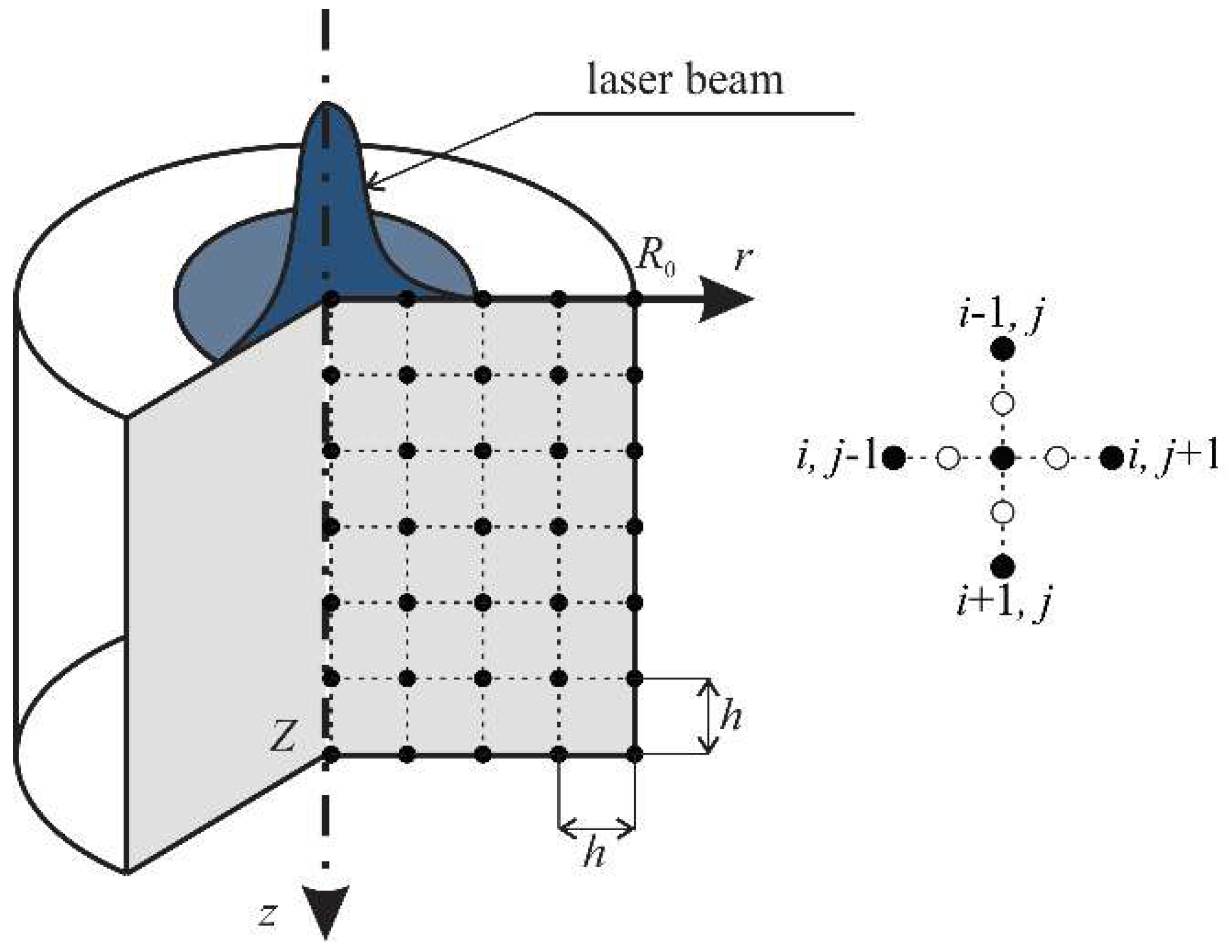
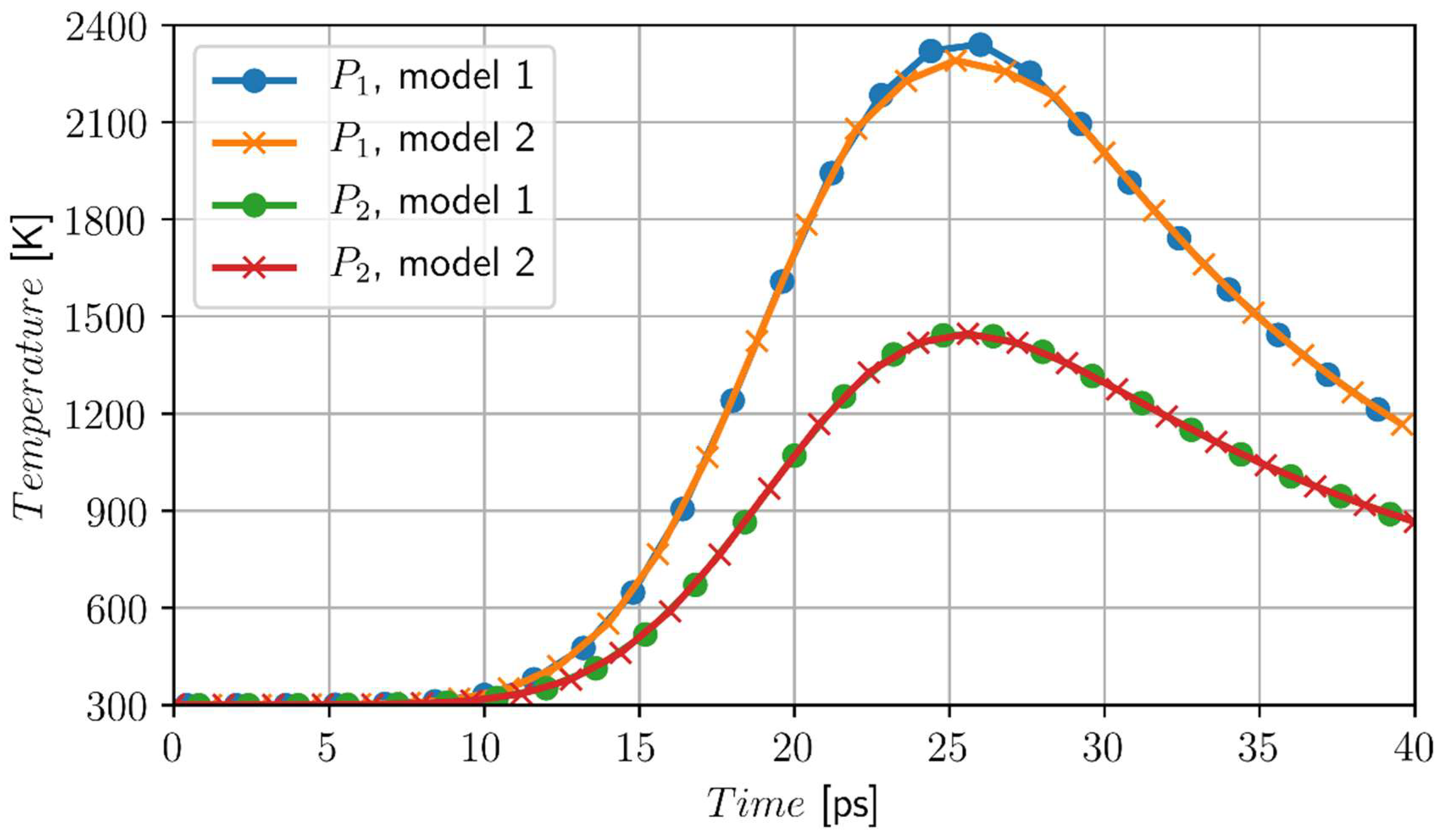
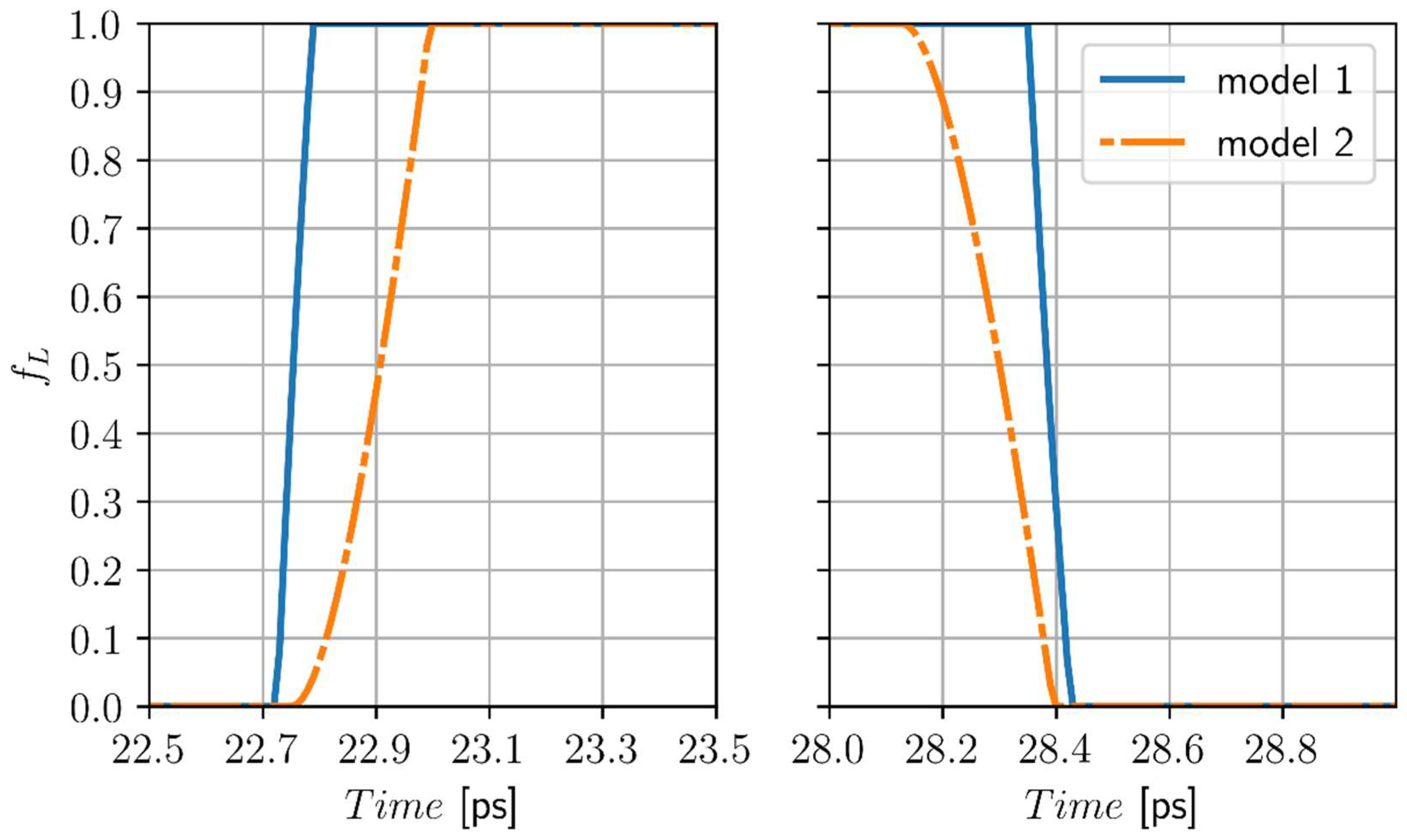
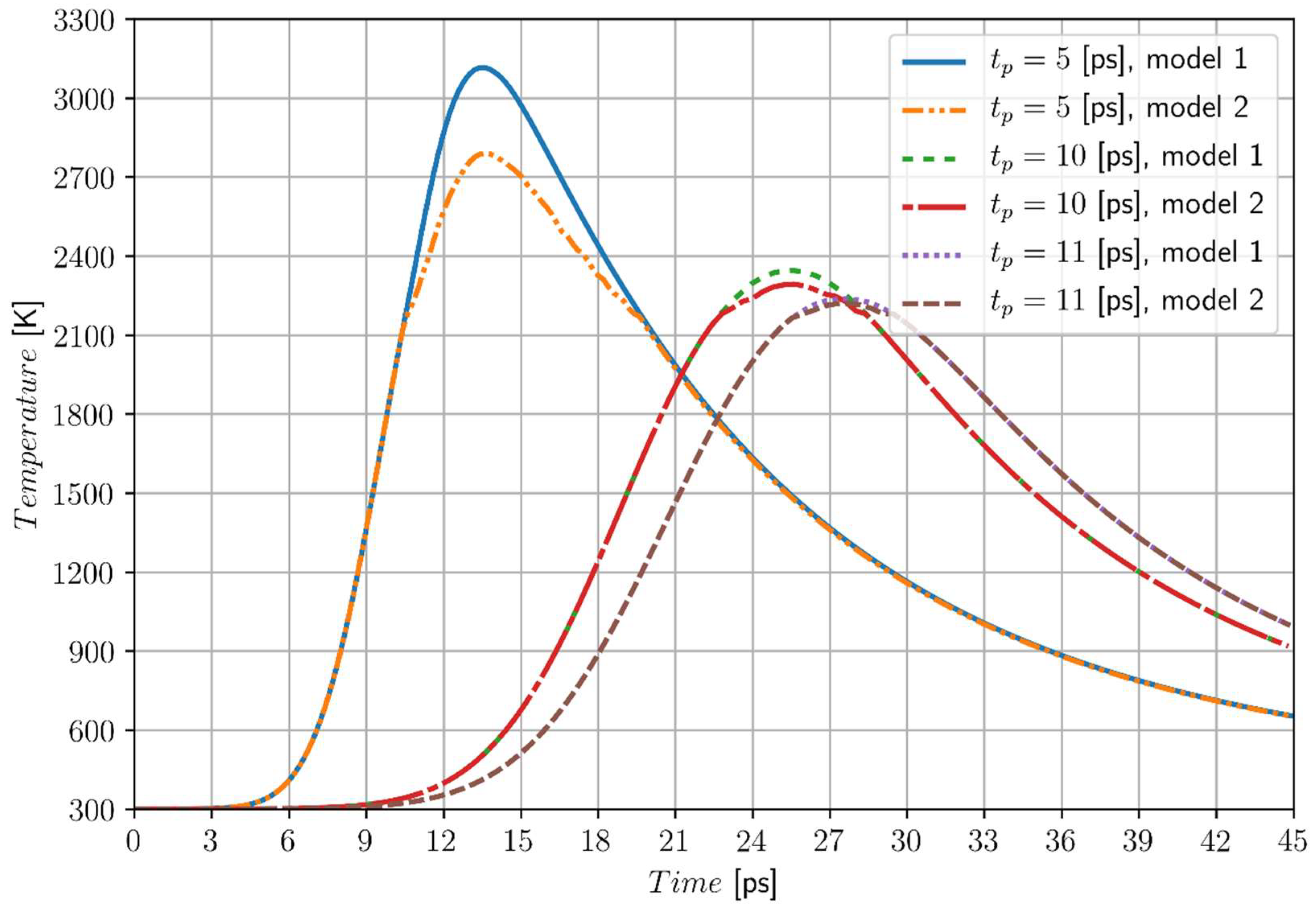
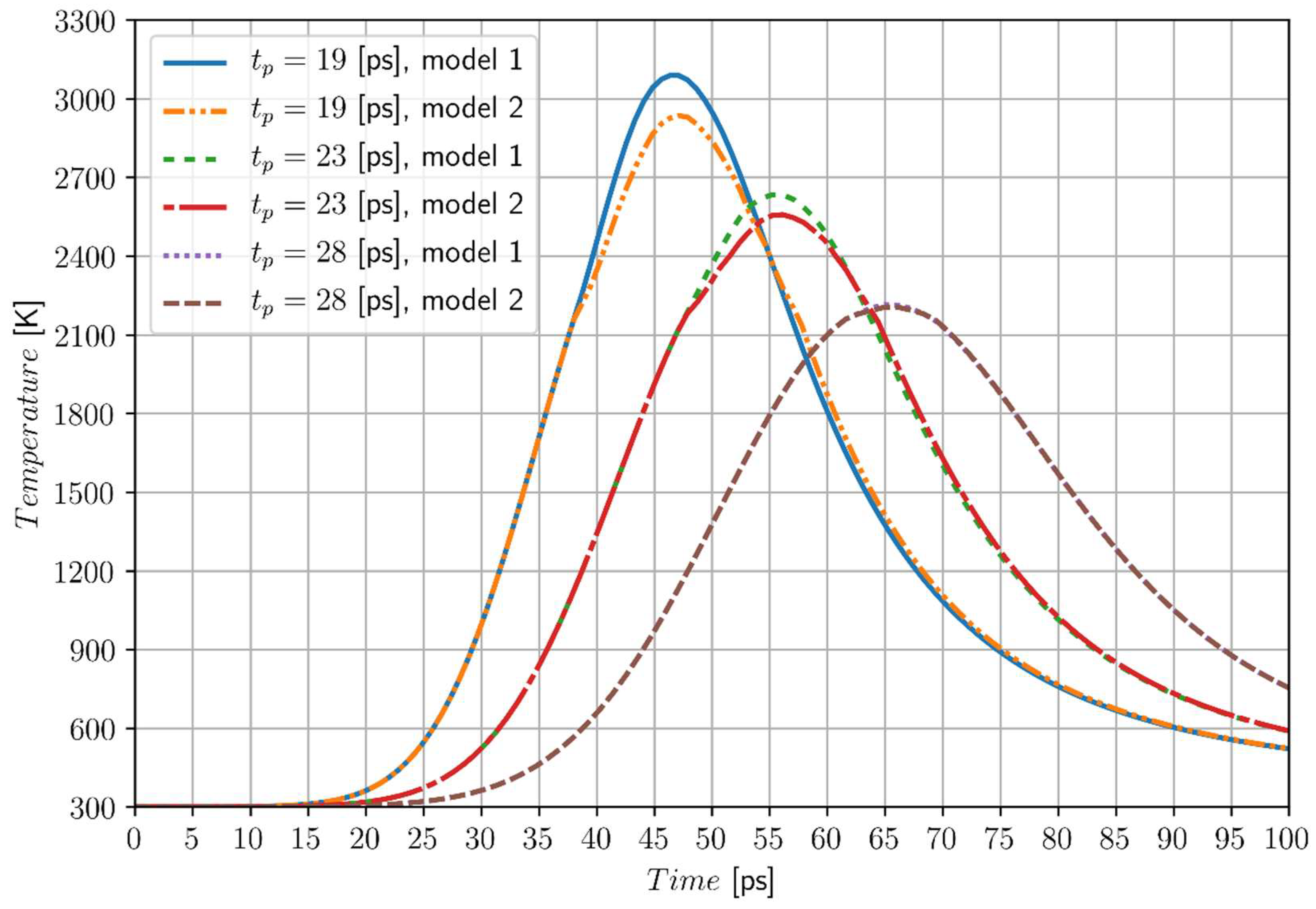
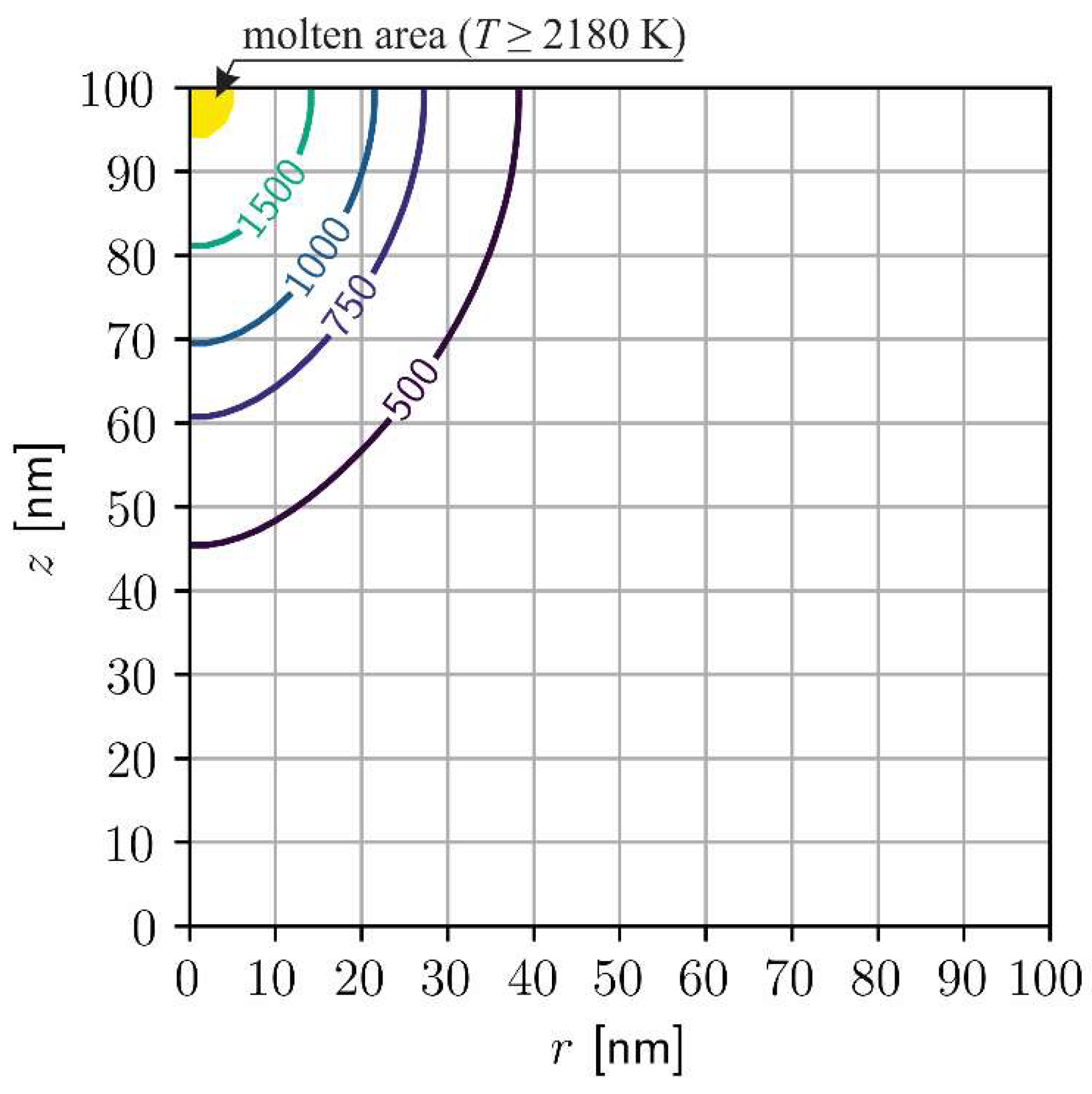
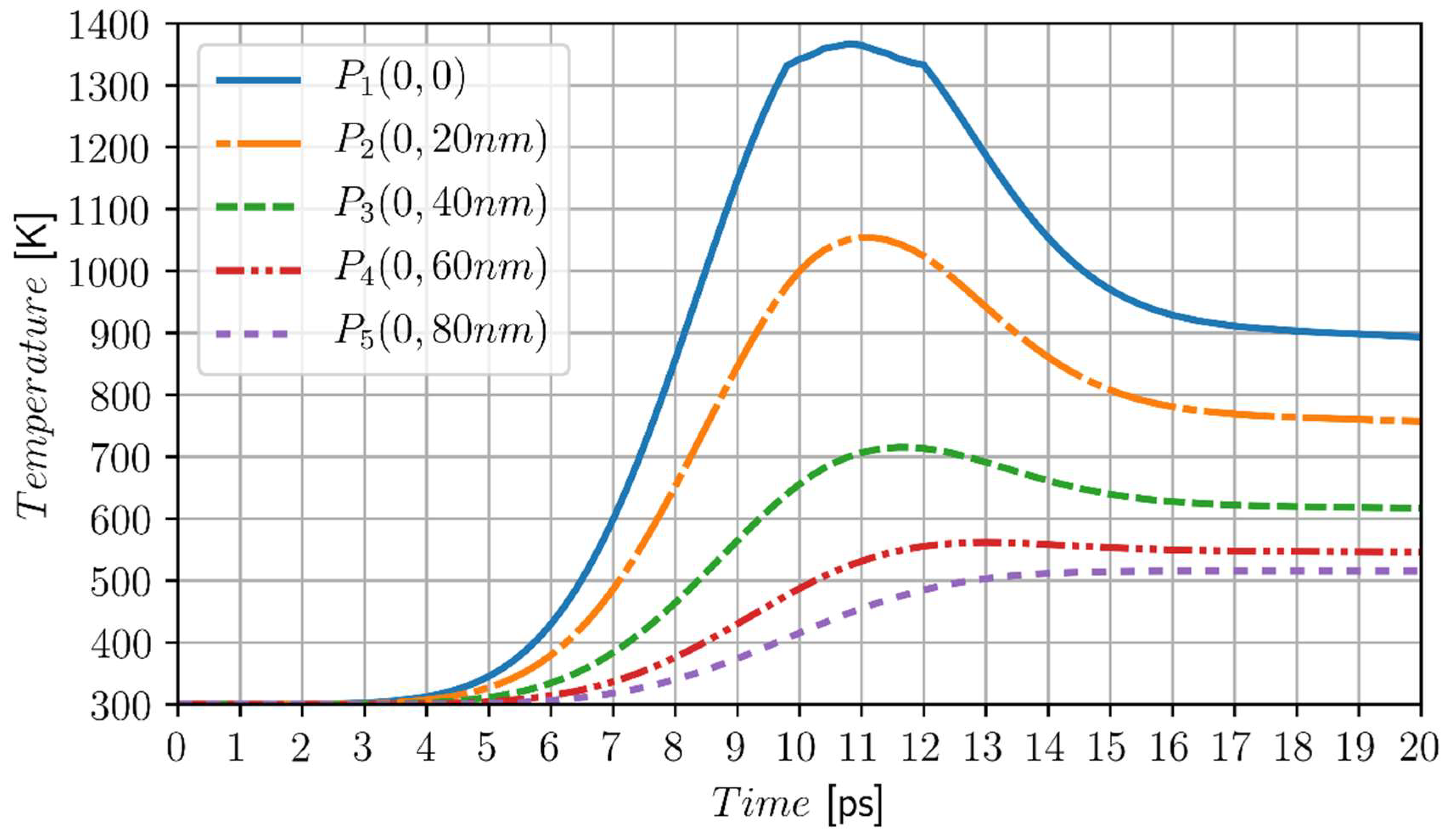
© 2018 by the authors. Licensee MDPI, Basel, Switzerland. This article is an open access article distributed under the terms and conditions of the Creative Commons Attribution (CC BY) license (http://creativecommons.org/licenses/by/4.0/).
Share and Cite
Majchrzak, E.; Mochnacki, B. Numerical Simulation of Thermal Processes in a Domain of Thin Metal Film Subjected to an Ultrashort Laser Pulse. Materials 2018, 11, 2116. https://doi.org/10.3390/ma11112116
Majchrzak E, Mochnacki B. Numerical Simulation of Thermal Processes in a Domain of Thin Metal Film Subjected to an Ultrashort Laser Pulse. Materials. 2018; 11(11):2116. https://doi.org/10.3390/ma11112116
Chicago/Turabian StyleMajchrzak, Ewa, and Bohdan Mochnacki. 2018. "Numerical Simulation of Thermal Processes in a Domain of Thin Metal Film Subjected to an Ultrashort Laser Pulse" Materials 11, no. 11: 2116. https://doi.org/10.3390/ma11112116




